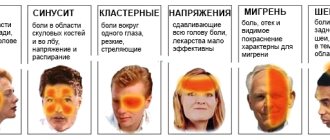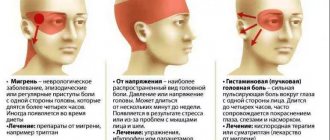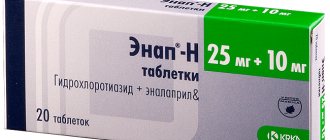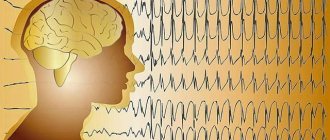Headache due to sinusitis is particularly severe and has an uncomfortable aching sensation. In rare cases, the disease occurs without this symptom, because sinusitis is not only a runny nose with purulent discharge. In order to get rid of pain, it is necessary to eliminate the source of the disease.
To do this, it is important to engage in timely and effective treatment, which should be prescribed by a doctor. Pain not only impairs the quality of life, but also leads to complex complications throughout the body.
How my head hurts
Headaches are varied. And many are afraid that they simply will not recognize it and will confuse it with another, for example, migraine. Doctors say that headaches with sinusitis are quite typical. It is often characterized as:
- bursting;
- pressing;
- turning into pulsation in the sinuses.
How long can it hurt?
This pain appears in the morning and begins to develop from the back of the head, approximately in the area of the back of the head or the crown. This is explained by the fact that during the night, when a person lies on his back, mucus accumulates in the maxillary sinuses. When he gets up, she starts to push. During the day it intensifies and begins to radiate to the forehead area.
If a person moves his head, and especially when bending forward, the pain intensifies . You can also feel unpleasant symptoms by simply pressing your fingers into the nose area. Often this is where the pulsation begins.
Where exactly and with what degree of intensity a headache occurs with sinusitis directly depends on how the disease progresses.
When it passes
The most unpleasant thing about this is that the painkillers that people use to eliminate symptoms only dull the discomfort, but do not eliminate the severity. A person’s condition improves only after properly selected and administered therapy. So, in advanced cases, this will happen only after the sinuses are punctured, when the purulent contents flow out and the pressure decreases.
This material will tell you how to identify sinusitis in an image.
What is sinusitis?
During a runny nose, the blood vessels dilate, the mucous surface of the nose swells and becomes inflamed. Increased mucus formation begins. If you don’t get rid of it in time, it begins to close the paranasal sinuses, accumulating there and forming a favorable environment for the proliferation of microbes and bacteria. Pus forms, which provokes unpleasant pain.
How to distinguish from migraine
Headache due to sinusitis is attributed to any problem other than nasal disease. And this is a minus, since time is lost during which the pathology can be cured with minimal losses. In this case, headaches due to sinusitis are confused with migraines. And they try to remove it with painkillers, rest, etc. Such measures aggravate and prolong the course of the disease.
Therefore, it is important to differentiate the types of unpleasant symptoms. With a migraine, pain in the head will manifest itself as strong pulses both in the entire area and on one side. Moreover, they are provoked by sharp sounds, bright light and even an inappropriate smell.
Headaches due to sinusitis necessarily have additional symptoms such as nasal congestion, breathing problems and loss of smell . A characteristic white or yellow discharge appears from the nose. With migraine, nausea and vomiting will be accompanying symptoms. Migraine is more common in women and is often inherited. Everyone suffers from sinusitis, regardless of gender and age.
In what cases is a CT scan of the maxillary sinuses prescribed? Find out here.
Diagnostics
Room for radiography.
First of all, in case of headaches that do not go away, it is necessary to carry out a differential diagnosis with:
- increased intracranial pressure;
- migraine;
- arterial hypertension;
- trigeminal neuralgia;
- consequences of brain injuries;
- vascular disorders.
To confirm the diagnosis, it is necessary to conduct a routine x-ray of the sinuses of the facial skull. If such X-ray images show fluid and deterioration of air conduction, then this is sinusitis.
Where does it hurt
Many people have a question: where does it hurt? Such information is important for diagnosing and distinguishing different pathologies from one another.
In the frontal part
Headache in adults with the development of sinusitis is usually localized in the frontal region. And this is understandable, because... The maxillary sinuses are located deep in the nasal cavity, just closer to the frontal zone. Therefore, the pressure caused by mucus accumulated in the nose makes itself felt especially persistently here. This symptom begins to appear at the initial stage, and then as the situation worsens it becomes more pronounced.
The pain intensifies when coughing, bending over, or taking a shower.
The sensation is unpleasant, pressing and affects the eyes, eyebrows and brow ridges. This is again explained by the proximity of the location of all these organs and body systems to the nose. There is not much space in the head, and most of the organs are closely intertwined. For example, teeth often hurt due to sinusitis - from the side where inflammation develops, it hurts to put pressure on the gums. If sinusitis is unilateral, unpleasant phenomena can be observed only on one side.
All information about unilateral sinusitis is presented in this article.
Throbbing pain in the back of the head and getting worse
In the back of the head, pressure is felt mainly in the morning and because pressure is directed here from the night. After all, a person lies on the pillow with the back of his head. After it disperses and finally wakes up, the pain also moves - it flows forward. Occipital pain with sinusitis indicates that the third stage of the disease has begun. And in such a situation, urgent treatment is required. Attacks can be more intense, and also appear when sneezing and even when leaving a warm room into a cold street - the temperature difference is triggered.
Pain in the temporal region - what to do if there is pressure on the temples
In the temples, pain due to sinusitis is explained by the same pressure spreading throughout the head. Usually they say that such a symptom appears after starting self-treatment of sinusitis without any consultation with a specialist. This symptom usually occurs in acute form of sinusitis, and only a set of measures can cope with it.
We also recommend that you familiarize yourself with the blood test indicators for sinusitis at this link.
Causes
In many cases, the main trigger for the development of sinusitis is a respiratory infection. For this reason, during the cold season, the number of patients who receive this diagnosis increases significantly. In addition, doctors identify some diseases that can cause the development of sinusitis without timely and effective treatment:
- Dental diseases. In particular, carious lesions of the teeth of the upper jaw can provoke the development of odontogenic sinusitis.
- The presence of a prolonged allergic reaction, which is accompanied by rhinitis;
- Pathology of the nasal septum, the curvature of which leads to a failure of free air circulation and the normal movement of mucous masses.
- The presence of a number of chronic infectious diseases and other pathological manifestations - adenoids, as well as pharyngitis, tonsillitis and others.
Other symptoms of the problem
Pain in the head with sinusitis is accompanied by other symptoms. And they are quite well defined by their affiliation with pathology. So before you try to relieve your headache, it's worth checking to see if any of the following are present.
Noise in my head
With an infectious disease, such as sinusitis, noise appears in the head. This unpleasant symptom is characterized as monotonous and rustling. Against this background, his ears begin to pop, his head is pulsating strongly. After all, air exchange in the nose is impaired, which causes swelling of the mucous membranes, inflammation and distortion of sound waves.
Pain in the head against the background of clear breathing
The nose can breathe with sinusitis - at a number of stages or in the chronic course of the disease, the ventilation of the nasal passages is not so severely impaired. But swelling of the mucous membrane inside remains, which interferes with the normal outflow of mucus and leads to its accumulation. The extra layer in the nose causes changes in physiological processes, which increase the pressure inside . This may cause headaches. But a person will be able to breathe. With sinusitis, if breathing persists, there is no sense of smell, i.e. a person cannot distinguish smells.
What does temperature mean for sinusitis is described here.
Severe dizziness
Dizziness with sinusitis also accompanies headaches. This symptom appears when sinusitis is advanced, when not only the maxillary sinuses are affected, but also the frontal sinuses. It intensifies in the following cases:
- when a person suddenly changes his body position - gets out of bed;
- while coughing or sneezing;
- after a short sleep (time of day does not matter).
For doctors, this symptom makes it clear that the infection has reached the labyrinth of the inner ear. This problem does not appear instantly; it is recognized 2-3 weeks after the onset of the disease.
The head is spinning due to intoxication of the body. There will be severe weakness and a feeling of nausea. Dizziness with sinusitis does not occur without pain in the head, because these two phenomena have a common nature.
Unpleasant sensations
The discomfort associated with sinusitis is varied. The nose is running, it itches, there is pressure on the head, it is noisy, buzzing and has trouble thinking clearly. All this is a consequence of a lack of oxygen due to clogged and swollen nasal passages. Moreover, all the symptoms are constantly getting worse. Against their background, a person becomes irritable and cannot work and rest normally . A headache makes you nervous and makes you worry and stress. Against this background, the course of the disease worsens and prolongs.
Eyes hurt
Pain and swelling of the eye with sinusitis occurs due to the proximity of the maxillary sinus and eye sockets. The infection moves into short periods, because bacteria enter the eye through fatty tissue, which fills the space between the eyeball, the fibers of the nervous system and the walls of the orbit of the eye. Signs of damage include symptoms such as heaviness in the eyelids and pain under the eyebrow, as well as in the depression near the eye. They intensify when turning the head.
Causes:
- strong pressure on the orbital area;
- inflammatory process - swelling of tissues also puts pressure on the eye;
- proximity of organs and systems.
How to treat and reduce headaches with sinusitis
Many people have a question: what to drink to alleviate the condition. It is important to note that you should take the medications suggested by the specialist. Self-prescribing treatment is not recommended.
The list of medicines includes:
- Antibiotics : these can be Azithromycin, Amoxicillin, Ceftriaxone and other options, including extended-spectrum drugs.
- Antihistamines : Zodak, Zyrtec, Fenistil, Suprastin.
- Probiotics - to restore flora after antibiotics: Hilak Forte, Linex, Bifidumbacterin.
- Nasal drops : Nazivin, Vibrocil, Rinofluimuil, Sofradex, Isofra.
The full course of treatment is up to 20 days, but not less than two weeks. A mandatory point in treatment to relieve headaches is taking antibiotics. It is important to choose the right remedy, because resistance has already begun to develop to many of them, i.e. sustainability. Tablets are used 2-3 times a day, the course must be prescribed by a doctor.
If the situation is advanced, the doctor suggests injection therapy. Headache due to sinusitis is also treated with special nasal drops - local antibiotics. But they must be used in combination. Such remedies alone cannot get rid of the disease.
If the headache does not go away when treatment is started, corticosteroids are prescribed. Such substances are strong and allow you to fight acute inflammation and noticeable pain in a short time.
How to relieve pain with drugs
Painkillers are prescribed, but they are generally available - we are talking about non-steroidal anti-inflammatory drugs: Nurofen, Nise and others. There is a possibility that they will help little . Therefore, the main hope is for basic treatment. In addition to antibiotics, the course of therapy also includes the use of antiseptics, antihistamines, vitamins, flora restoration products, etc.
Complications
Sinusitis poses a health hazard in the future, as the accumulation of pus in the sinuses will make breathing difficult and is also a source of infection. Therefore, the development of the following pathologies is possible if the treatment was incorrect or completely absent:
- meningitis due to penetration of microorganisms;
- loss of the protective properties of the nasal mucosa, changes in its structure;
- the appearance of symptoms of sinusitis and inflammation of other sinuses;
- tonsillitis - when microorganisms are introduced into the tonsils;
- inflammation of the nasal bones - osteoperiostitis - with long-term purulent sinusitis.
Sinusitis should be treated comprehensively, following the recommendations of the attending physician. This is the only way to avoid dangerous complications and not harm your own health.
Results
- Headache due to sinusitis is a common occurrence. She is described as exhausting and strong.
- It is impossible to ignore a headache due to sinusitis, because... it indicates that the situation is getting more complicated.
- Headache due to sinusitis is different from migraine. It is mainly localized in the front of the head and can radiate to one side. Also, such pain is accompanied by the following symptoms: nasal discharge, soreness in the nose, ear congestion due to sinusitis.
- In this case, headache treatment should be handled by a specialist, because Treatment with antibiotics and even corticosteroids is often required. Self-prescribing painkillers for yourself leads to a worsening of the situation.
Special Recommendations
In order for the treatment prescribed by the doctor to produce the necessary results, it is necessary to follow a number of recommendations:
- It is imperative to ventilate the room.
- It is recommended to massage the neck and head.
- Aromatherapy helps.
- Rinsing the nose with saline solutions. You can make infusions from medicinal herbs (chamomile, calendula).
- Physiotherapeutic procedures will effectively treat sinusitis and shorten the duration of the disease.
- Taking vitamins and minerals.
- Dieting. Fatty, spicy, too salty and sweet foods should be excluded from the diet.
Sinusitis, in turn, can cause otitis media, conjunctivitis and other inflammatory diseases of internal organs. It is very important to treat the nose for purulent discharge.
If the pain is intermittent and there are no signs of illness, then the cause may be migraine or fatigue. These disorders require completely different treatment.











